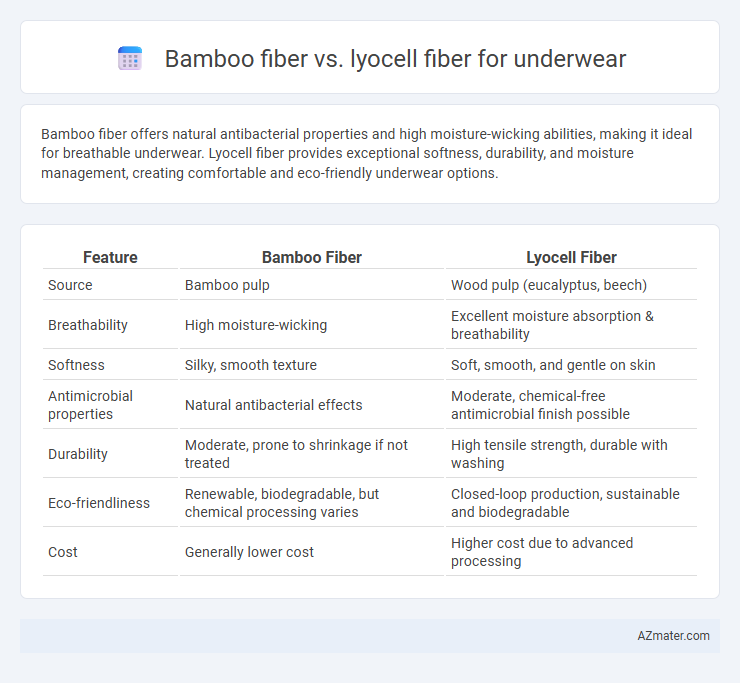Bamboo fiber offers natural antibacterial properties and high moisture-wicking abilities, making it ideal for breathable underwear. Lyocell fiber provides exceptional softness, durability, and moisture management, creating comfortable and eco-friendly underwear options.
Table of Comparison
| Feature | Bamboo Fiber | Lyocell Fiber |
|---|---|---|
| Source | Bamboo pulp | Wood pulp (eucalyptus, beech) |
| Breathability | High moisture-wicking | Excellent moisture absorption & breathability |
| Softness | Silky, smooth texture | Soft, smooth, and gentle on skin |
| Antimicrobial properties | Natural antibacterial effects | Moderate, chemical-free antimicrobial finish possible |
| Durability | Moderate, prone to shrinkage if not treated | High tensile strength, durable with washing |
| Eco-friendliness | Renewable, biodegradable, but chemical processing varies | Closed-loop production, sustainable and biodegradable |
| Cost | Generally lower cost | Higher cost due to advanced processing |
Introduction to Bamboo and Lyocell Fibers
Bamboo fiber, derived from the pulp of bamboo grass, offers natural antibacterial properties and excellent moisture-wicking capabilities, making it ideal for sensitive skin in underwear. Lyocell fiber, created from sustainably sourced eucalyptus wood pulp using a closed-loop process, provides superior breathability, softness, and durability. Both fibers emphasize eco-friendliness and comfort, with bamboo focusing on natural antimicrobial benefits and lyocell on high-performance moisture management.
Fiber Origins and Sustainability
Bamboo fiber originates from bamboo plants and is celebrated for its rapid growth and minimal need for pesticides, making it a highly sustainable raw material for underwear manufacturing. Lyocell fiber is derived from sustainably sourced eucalyptus, beech, or spruce trees using a closed-loop solvent spinning process that recycles water and chemicals, significantly reducing environmental impact. Both fibers offer eco-friendly alternatives, but bamboo's natural renewability contrasts with lyocell's advanced industrial process aimed at maximizing sustainability in textile production.
Production Processes Compared
Bamboo fiber is produced through a chemical-intensive process called viscose or rayon production, involving the treatment of bamboo cellulose with strong solvents that can impact environmental sustainability. Lyocell fiber, derived from wood pulp, uses a closed-loop solvent spinning method that recycles almost 99% of the non-toxic solvent, making it a more eco-friendly choice. Both fibers offer softness and breathability for underwear, but lyocell's production process significantly reduces chemical waste and energy consumption compared to traditional bamboo viscose manufacturing.
Environmental Impact and Eco-Friendliness
Bamboo fiber and Lyocell fiber both offer eco-friendly options for underwear, with bamboo requiring less water and pesticides due to its natural fast growth, significantly reducing environmental strain. Lyocell, derived from sustainably sourced wood pulp through a closed-loop process, minimizes chemical waste and enhances biodegradability. Both fibers provide breathable, moisture-wicking properties, but bamboo's cultivation footprint and lyocell's production efficiency are critical factors in their overall environmental impact.
Softness and Comfort for Underwear
Bamboo fiber offers exceptional softness and natural moisture-wicking properties, making it highly breathable and comfortable for underwear. Lyocell fiber provides a smooth, silky texture with excellent moisture management and durability, ensuring long-lasting softness and comfort. Both fibers excel in softness and comfort, but bamboo is often preferred for its natural antibacterial qualities, enhancing freshness during wear.
Breathability and Moisture Wicking Properties
Bamboo fiber offers exceptional breathability due to its natural micro-gaps, allowing air circulation that helps keep the skin cool and dry. Lyocell fiber, produced through a sustainable process from eucalyptus wood, excels in moisture-wicking by efficiently absorbing and releasing perspiration, maintaining comfort during prolonged wear. Both fibers contribute to enhanced underwear performance, with bamboo prioritizing ventilation and lyocell optimizing moisture management.
Durability and Longevity
Bamboo fiber offers moderate durability with natural antibacterial properties, but it tends to degrade faster than lyocell when subjected to frequent washing and wear. Lyocell fiber, derived from sustainable wood pulp, excels in tensile strength and resistance to abrasion, ensuring superior longevity for underwear. Both fibers are breathable and moisture-wicking, yet lyocell's enhanced durability makes it a preferred choice for long-lasting intimate apparel.
Skin Sensitivity and Hypoallergenic Features
Bamboo fiber offers natural antimicrobial and moisture-wicking properties, making it ideal for sensitive skin and reducing irritation. Lyocell fiber, derived from sustainable eucalyptus trees, provides a smooth, hypoallergenic texture that minimizes allergic reactions and enhances breathability. Both fibers excel in skin sensitivity, but bamboo's inherent antibacterial qualities give it a slight edge for hypoallergenic underwear.
Cost and Accessibility for Consumers
Bamboo fiber underwear typically offers a lower price point compared to lyocell, making it more accessible for budget-conscious consumers. Lyocell, derived from sustainably sourced wood pulp, tends to be costlier due to its eco-friendly manufacturing process and premium softness. Both fibers are widely available, but bamboo garments often appear in more mainstream retailers, increasing ease of purchase.
Final Verdict: Which Fiber is Better for Underwear?
Bamboo fiber offers excellent moisture-wicking, natural antibacterial properties, and unmatched softness, making it ideal for sensitive skin and breathable underwear. Lyocell fiber provides superior durability, smooth texture, and eco-friendly production with closed-loop processing, ensuring minimal environmental impact. For underwear prioritizing comfort and sustainability, bamboo excels in softness and odor control, whereas lyocell outperforms in strength and eco-conscious credentials, with the final choice depending on individual preferences for softness versus durability.

Infographic: Bamboo fiber vs Lyocell fiber for Underwear
 azmater.com
azmater.com